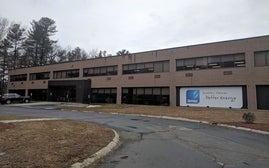Is AMSC Positioning Itself For A Turnaround?
After losing its biggest customer in the spring of 2011, the Devens wind power and electric grid company formerly known as American Superconductor cut its workforce in half, lost more than $100 million and watched its share price — which had reached over $40 in early 2010 — fall below $4.
When Aaron Chew began covering the company for the investment firm Maxim Group in April 2012, it was by urging investors to buy.
“I’m their only supporter,” Chew said with a laugh. “It’s easy for me to be a supporter because I’m new to the stock.”
Chew isn’t joking. He thinks he sees something that might escape analysts who have been covering the company for a while — the fact that AMSC really is a different company than American Superconductor was. It’s driven down costs and added customers, and Chew thinks leadership has a solid plan. More importantly, it’s a whole different proposition to buy a $4 stock than a $40 one.
“I’m certainly not saying I have zero worries,” he said. “It’s just a question of risk-reward.”
Last month, AMSC announced the sale of 50 of its wind-turbine control systems to India’s Inox Group. It’s not a game-changing deal by itself — Chew estimates it’s worth about $10 million. But with pared-back expenses, that kind of sale makes a difference.
“If they could find five of those deals, I think they’re fine,” Chew said.
Chew notes there’s no guarantee that will happen. And other analysts are considerably more pessimistic.
Challenging Industry
JinMing Liu, who covers AMSC for Ardour Capital Investments LLC, said part of AMSC’s trouble is simply that it’s in a tough industry. The U.S. producer tax credit that had boosted wind power is set to expire, and the low price of natural gas is putting pressure on alternative energy sources, so there are few projects in the pipeline in this country. The European market is flat, Liu said, and China has problems with the overbuilding of wind farms and regulatory changes that make it hard to set up turbines. There’s potential in emerging wind markets like India, but not enough to make up for the decline elsewhere.
Liu also notes that there are a huge number of wind-turbine companies — 70 or 80 in China alone.
Still, he and Chew both note that AMSC has valuable technology. It makes control systems for turbines that can make the most of whatever wind is available, as well as products that help connect distributed power sources to the grid smoothly. The company also does work with superconducting wires, but Liu said that’s years away from driving real income.
“The bottom line is, it is not big enough to support their cost,” he said. “They need more orders.”
AMSC gets about two-thirds of its revenue from the wind business, according to Jason Fredette, vice president of marketing and communications. Fredette wrote in an email that the amount of wind power being installed worldwide is growing each year, particularly in emerging economies, where the company has had the most success recently. The company is expanding its customer base, he said. On the wind side, AMSC is working mainly with Asian companies to help scale operations and improve turbine performance.
Private Investment Helps
AMSC bought itself a little more time for a rebound this April when it got $25 million in financing from an undisclosed private investor. Chew said the terms on the debt aren’t the best — for one thing, they allow the investors to convert it to preferred stock, diluting the company’s value — but they’re not a disaster either, especially since AMSC didn’t have any debt before that.
Meanwhile, AMSC probably still gets the most attention for its ongoing legal fight with former major customer Sinovel Wind Group. AMSC is seeking $1.2 billion through Chinese courts, saying Sinovel failed to pay for products it ordered — even some it had received — and stole intellectual property. Sinovel filed a counterclaim over the quality of the components it received from AMSC.
Neither Liu nor Chew thinks AMSC is likely to get very much of the $1.2 million. That’s because most of it involves a claim over goods that were ordered but never delivered, and another large chunk is about intellectual property, something Chinese courts are not known for defending. Liu said he thinks AMSC is unlikely to get anything from the cases because the counterclaim could balance out any award it might be entitled to. But Chew thinks the company could easily get $67 million that involves goods that were actually delivered but not paid for.
“That’s straight theft,” he said. “If they don’t win that case I’d be shocked.”
Even so, Chew said, a one-time infusion of $67 million wouldn’t be enough to turn a failing company into a thriving one. For that, AMSC needs to figure out whether it can diversify its customers and market its technology well enough.
Last week, AMSC announced that it dramatically narrowed its losses in its most recent fiscal quarter from $185.1 million to $21.2 million. Fredette said the company has not set a public goal for turning a profit again, but it’s narrowing its losses and approaching sustainable profitability. n












0 Comments